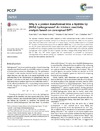Identificador persistente para citar o vincular este elemento:
https://accedacris.ulpgc.es/jspui/handle/10553/75028
| Campo DC | Valor | idioma |
|---|---|---|
| dc.contributor.author | Qiu, Siyao | en_US |
| dc.contributor.author | Azofra Mesa, Luis Miguel | en_US |
| dc.contributor.author | MacFarlane, Douglas R. | en_US |
| dc.contributor.author | Sun, Chenghua | en_US |
| dc.date.accessioned | 2020-10-27T09:54:22Z | - |
| dc.date.available | 2020-10-27T09:54:22Z | - |
| dc.date.issued | 2016 | en_US |
| dc.identifier.issn | 1463-9076 | en_US |
| dc.identifier.uri | https://accedacris.ulpgc.es/handle/10553/75028 | - |
| dc.description.abstract | The hydrogen evolution reaction (HER) catalysed by [NiFe] hydrogenases entails a series of chemical events involving great mechanistic interest. In an attempt to understand and delve into the question about ‘Why does nature work in that way?’, an in-depth intrinsic reactivity analysis based on conceptual DFT has been carried out focusing on the so-called I1 to Ni-C step, i.e. our work tries to answer how and why the proton attached to the reactive sulphur atom from one of the exo-cyclic cysteine residues is transformed into a bridging hydride to be shared between the Ni/Fe metals in the active site of [NiFe] hydrogenases, which involves not only H migration, but also a change of the charge state on Ni from Ni(I) to Ni(III). Our DFT results suggest that the transformation is motivated by spontaneous rearrangements of the electron density, and stabilisation comes from the decrease of both electronic activity and electrophilicity index from Ni. | en_US |
| dc.language | eng | en_US |
| dc.relation.ispartof | Physical Chemistry Chemical Physics | en_US |
| dc.source | Physical chemistry chemical physics [ISSN 1463-9076], 18, n. 22, p. 15369-15374 | en_US |
| dc.subject | 2210 Química física | en_US |
| dc.title | Why is a proton transformed into a hydride by [NiFe] hydrogenases? An intrinsic reactivity analysis based on conceptual DFT | en_US |
| dc.type | info:eu-repo/semantics/article | en_US |
| dc.type | Article | en_US |
| dc.identifier.doi | 10.1039/c6cp00948d | en_US |
| dc.description.lastpage | 15374 | en_US |
| dc.identifier.issue | 22 | - |
| dc.description.firstpage | 15369 | en_US |
| dc.relation.volume | 18 | en_US |
| dc.investigacion | Ciencias | - |
| dc.type2 | Artículo | en_US |
| dc.description.numberofpages | 6 | en_US |
| dc.identifier.ulpgc | No | - |
| dc.description.sjr | 1,678 | |
| dc.description.jcr | 4,123 | |
| dc.description.sjrq | Q1 | |
| dc.description.jcrq | Q1 | |
| dc.description.scie | SCIE | |
| item.grantfulltext | open | - |
| item.fulltext | Con texto completo | - |
| crisitem.author.dept | GIR IUNAT: Fotocatálisis y espectroscopía para aplicaciones medioambientales. | - |
| crisitem.author.dept | IU de Estudios Ambientales y Recursos Naturales | - |
| crisitem.author.orcid | 0000-0003-4974-1670 | - |
| crisitem.author.parentorg | IU de Estudios Ambientales y Recursos Naturales | - |
| crisitem.author.fullName | Azofra Mesa, Luis Miguel | - |
| Colección: | Artículos | |
Citas de WEB OF SCIENCETM
Citations
13
actualizado el 08-jun-2025
Visitas
97
actualizado el 19-ene-2025
Descargas
209
actualizado el 19-ene-2025
Google ScholarTM
Verifica
Altmetric
Comparte
Exporta metadatos
Los elementos en ULPGC accedaCRIS están protegidos por derechos de autor con todos los derechos reservados, a menos que se indique lo contrario.
